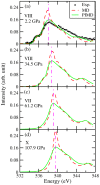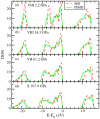Quantum simulation of thermally-driven phase transition and oxygen K-edge x-ray absorption of high-pressure ice
- PMID: 24253589
- PMCID: PMC3834560
- DOI: 10.1038/srep03272
Quantum simulation of thermally-driven phase transition and oxygen K-edge x-ray absorption of high-pressure ice
Abstract
The structure and phase transition of high-pressure ice are of long-standing interest and challenge, and there is still a huge gap between theoretical and experimental understanding. The quantum nature of protons such as delocalization, quantum tunneling and zero-point motion is crucial to the comprehension of the properties of high-pressure ice. Here we investigated the temperature-induced phase transition and oxygen K-edge x-ray absorption spectra of ice VII, VIII and X using ab initio path-integral molecular dynamics simulations. The tremendous difference between experiments and the previous theoretical predictions is closed for the phase diagram of ice below 300 K at pressures up to 110 GPa. Proton tunneling assists the proton-ordered ice VIII to transform into proton-disordered ice VII where only thermal activated proton-transfer cannot occur. The oxygen K edge with its shift is sensitive to the order-disorder transition, and therefore can be applied to diagnose the dynamics of ice structures.
Figures






Similar articles
-
Tunneling and delocalization effects in hydrogen bonded systems: a study in position and momentum space.J Chem Phys. 2009 May 28;130(20):204511. doi: 10.1063/1.3142828. J Chem Phys. 2009. PMID: 19485461
-
Effect of salt on the H-bond symmetrization in ice.Proc Natl Acad Sci U S A. 2015 Jul 7;112(27):8216-20. doi: 10.1073/pnas.1502438112. Epub 2015 Jun 22. Proc Natl Acad Sci U S A. 2015. PMID: 26100876 Free PMC article.
-
Phase Transition of Ice at High Pressures and Low Temperatures.Molecules. 2020 Jan 23;25(3):486. doi: 10.3390/molecules25030486. Molecules. 2020. PMID: 31979295 Free PMC article.
-
Hydrogen bond topology and the ice VII/VIII and Ih/XI proton ordering phase transitions.Phys Rev E Stat Nonlin Soft Matter Phys. 2006 May;73(5 Pt 2):056113. doi: 10.1103/PhysRevE.73.056113. Epub 2006 May 16. Phys Rev E Stat Nonlin Soft Matter Phys. 2006. PMID: 16803004
-
The low-temperature proton-ordered phases of ice predicted by ab initio methods.Phys Chem Chem Phys. 2005 Nov 7;7(21):3733-7. doi: 10.1039/b508736h. Epub 2005 Sep 14. Phys Chem Chem Phys. 2005. PMID: 16358022
Cited by
-
Nuclear quantum dynamics in dense hydrogen.Sci Rep. 2014 Jun 27;4:5484. doi: 10.1038/srep05484. Sci Rep. 2014. PMID: 24968754 Free PMC article.
-
Ice Regelation: Hydrogen-bond extraordinary recoverability and water quasisolid-phase-boundary dispersivity.Sci Rep. 2015 Sep 9;5:13655. doi: 10.1038/srep13655. Sci Rep. 2015. PMID: 26351109 Free PMC article.
References
-
- Huang Y. et al. Hydrogen bond asymmetric local potentials in compressed ice. J. Phys. Chem. B 10.1021/jp407836n (2013). - PubMed
-
- Guillot T. Interiors of giant planets inside and outside the solar system. Science 286, 72–77 (1999). - PubMed
-
- Lissauer J. J. Extrasolar planets. Nature 419, 355–358 (2002). - PubMed
-
- Malenkov G. Liquid water and ices: Understanding the structure and physical properties. J. Phys.: Condens. Matter 21, 283101 (2009). - PubMed
Publication types
MeSH terms
Substances
LinkOut - more resources
Full Text Sources
Other Literature Sources
Miscellaneous

